'Pete's Dragon' Was Not Disney's First, or Strangest Dragon
Meet the OG friendly dragon that's queer-coded.

The remake of Pete’s Dragon is out next week, and it looks pretty magical… and mercifully less about child slavery than the 1977 musical version was. But, did you know he was not Disney’s first friendly fire-breather?
Today the loveable, dog-like dragon is just as common and equally popular narrative fixture as the giant, fuck-shit-up dragons of The Hobbit and Game of Thrones. However, the leap from monster to pal is a relatively recent advancement in the long history of dragon narratives.
That leap is credited to The Reluctant Dragon, the OG friendly dragon conceived in 1898 by Kenneth Grahame, in a short story of the same name. The story is a parody of the classic chivalric narrative in the vein of Don Quixote. It portrays a dragon who befriends a boy and is afraid to fight a knight. Together, they agree on a plan to stage the fight and satisfy the townsfolk’s bloodlust. After centuries of scary, destructive, immoral dragons, The Reluctant Dragon introduced the chill dragon trend that has since given us the likes of Elliot and Toothless.
In 1941, Disney adapted the story into an animated feature that was combined with a live-action, behind the scenes movie about Disney’s animation studios. The film as a whole is a fascinating time capsule of the state of animation at the time, intercut with a couple of original shorts. But, most interesting is how they characterized the big screen’s first ever friendly dragon.
Grahame’s story casts the dragon as wise and eloquent, but Disney elected to preserve only one detail, the fact that he loves poetry. Aside from that, they recast the dragon as a comedic character, with a large girth and delicate sensibilities. The boy finds him bathing, and the dragon modestly covers himself. In other scenes, he hikes up his large belly like a woman’s skirt. His exaggerated mannerisms and effeminate hobbies like picnics and ballroom dancing look an awful lot like a queer caricature when viewed in the year 2016.
Of course, the point of The Reluctant Dragon was to reverse the stereotypes found in traditional dragon and knight tales, so we see the knight, Sir Giles, also presented as markedly “unmanly”. The boy first encounters Sir Giles, a scrawny older man, bathing himself, much like the dragon. Sir Giles is full of bluster about his dragon slaying prowess, but is quickly enchanted when he meets the dragon. They share an affinity for tea and poetry.
Their choreographed fight is exactly the kind of goofy action sequence that Disney loved so as to show off their animation prowess. It’s still a delightful little short, but the presentation of two characters coded subtextually as queer comes off as odd and dated. More recent iterations of the friendly dragon archetype, such as the new Pete’s Dragon and How to Train Your Dragon avoid anthropomorphizing their dragons too much, and instead give them affectionate animal mannerisms.
Gender-bending and queer coding have long been attributed to villains, and Disney is a particularly egregious perpetrator of this practice. This time it seems to be played for relatively harmless laughs. The creators use the effeminate characterization to portray the characters as the total opposite of the traditional dragon and knight archetypes.
The most important thing about The Reluctant Dragon was how much it struck a chord with audiences. That particular story was adapted many times on stage and television—most notably The Shirley Temple Show—and it opened doors for other personable, friendly monsters.
